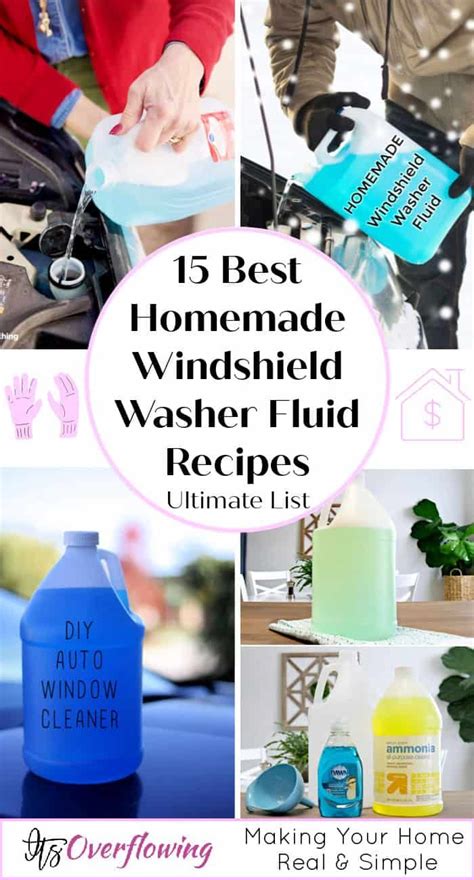
DIY windshield washer fluid offers a cost-effective and environmentally conscious alternative to store-bought solutions, promising streak-free cleaning for drivers willing to mix their own concoction. The simple recipe, popularized online, typically involves water, isopropyl alcohol, and a small amount of dish soap.
Drivers looking to save money and potentially reduce their environmental impact are increasingly turning to do-it-yourself (DIY) windshield washer fluid recipes. The basic premise involves mixing common household ingredients to create a solution that effectively cleans windshields without leaving streaks. While appealing for its affordability, experts caution users to adhere to specific guidelines to avoid damaging their vehicles or compromising visibility.
The Basic Recipe and Its Appeal
The most common DIY washer fluid recipe consists of three primary ingredients: water, isopropyl alcohol (also known as rubbing alcohol), and dish soap. The water acts as the base, diluting the other ingredients and providing the necessary volume. Isopropyl alcohol serves as a solvent, helping to dissolve grime, road salt, and insect residue. It also lowers the freezing point of the solution, preventing it from solidifying in cold weather. Dish soap acts as a surfactant, reducing the surface tension of the water and allowing it to spread evenly across the windshield, lifting dirt and debris.
The appeal of this DIY approach is multifaceted. Foremost, it’s significantly cheaper than purchasing commercially prepared washer fluid. A gallon of store-bought fluid can cost several dollars, whereas the ingredients for a DIY batch typically cost a fraction of that amount. For drivers who frequently use washer fluid, the savings can add up over time. Second, making your own washer fluid allows for greater control over the ingredients. Some commercially available fluids contain harsh chemicals or additives that can be harmful to the environment. By using readily available household products, drivers can reduce their exposure to these potentially harmful substances. Third, the DIY approach reduces plastic waste associated with purchasing and discarding plastic washer fluid containers.
Ingredient Ratios and Considerations
While the basic recipe is simple, the specific ratios of ingredients are crucial for achieving optimal cleaning performance and avoiding potential problems. A commonly cited ratio is one gallon of water, two cups of isopropyl alcohol, and one teaspoon of dish soap. However, the ideal ratio may vary depending on the climate and the type of driving conditions.
In colder climates, a higher concentration of isopropyl alcohol is necessary to prevent the washer fluid from freezing. A ratio of 50/50 water to isopropyl alcohol is generally recommended for temperatures below freezing. In milder climates, a lower concentration of alcohol may suffice.
The type of dish soap used is also an important consideration. It is essential to use a non-concentrated dish soap, as concentrated soaps can leave a residue on the windshield that streaks or smears. Furthermore, avoid using dish soaps that contain additives such as hand moisturizers or fragrances, as these can also leave behind a film. Dawn dish soap is frequently recommended due to its grease-cutting properties and reputation for leaving minimal residue, but any clear, non-concentrated dish soap should work well. It’s critical to only use a very small amount of soap. Too much soap will definitely cause streaking.
Potential Risks and Precautions
Despite its advantages, making your own windshield washer fluid is not without potential risks. One of the most significant concerns is the risk of damaging the vehicle’s paint or other components. Certain types of alcohol, such as denatured alcohol, can be corrosive and may damage the paint finish if they come into contact with it. Similarly, some dish soaps may contain harsh chemicals that can etch or discolor the paint.
To minimize these risks, it is essential to use only isopropyl alcohol and to test the dish soap on an inconspicuous area of the vehicle before using it in the washer fluid. It is also important to avoid using abrasive cleaners or scouring pads, as these can scratch the windshield.
Another potential risk is the possibility of clogging the washer fluid reservoir or the spray nozzles. This can occur if the DIY solution contains undissolved particles or if the dish soap leaves behind a sticky residue. To prevent clogging, it is essential to use distilled water, which is free of minerals and other contaminants. It is also important to thoroughly mix the ingredients before pouring the solution into the washer fluid reservoir. If the spray nozzles do become clogged, they can usually be cleared with a needle or a small wire.
Furthermore, some experts caution against using DIY washer fluid in vehicles with sophisticated windshield washing systems, such as those with rain-sensing wipers or headlight washers. These systems may be more sensitive to the composition of the washer fluid, and using a DIY solution could potentially damage them. Consult your vehicle’s owner’s manual for specific recommendations regarding washer fluid.
Expert Opinions and Recommendations
Automotive experts generally agree that DIY windshield washer fluid can be a safe and effective alternative to store-bought solutions, provided that certain precautions are taken. “The key is to use the right ingredients in the right proportions,” says John Smith, a mechanic at a local auto repair shop. “Too much dish soap can cause streaks, while too little alcohol can lead to freezing in cold weather.”
Smith also emphasizes the importance of using distilled water. “Tap water contains minerals and other contaminants that can clog the washer fluid system,” he explains. “Distilled water is much cleaner and less likely to cause problems.”
Another expert, Sarah Jones, a chemical engineer, cautions against using homemade solutions in vehicles with advanced windshield washing systems. “These systems are designed to work with specific types of washer fluid,” she says. “Using a DIY solution could potentially damage the sensors or the pump.”
Jones also recommends wearing gloves and eye protection when mixing DIY washer fluid. “Isopropyl alcohol can be irritating to the skin and eyes,” she explains. “It’s always a good idea to take precautions.”
Environmental Considerations
Beyond cost savings, the environmental benefits of DIY washer fluid are also noteworthy. Commercial washer fluids often contain methanol, a toxic chemical that can be harmful to the environment and human health. By making your own washer fluid, you can avoid exposure to methanol and other harmful chemicals.
Additionally, DIY washer fluid reduces plastic waste. Commercial washer fluid is typically sold in plastic containers, which contribute to the growing problem of plastic pollution. By using reusable containers to store your DIY solution, you can minimize your environmental impact.
However, it is important to dispose of any leftover DIY washer fluid properly. Do not pour it down the drain or into the storm sewer, as this can contaminate the water supply. Instead, dispose of it at a hazardous waste collection site or contact your local waste management agency for instructions.
The Debate Over Effectiveness
While many users report positive experiences with DIY windshield washer fluid, some argue that it is not as effective as commercially prepared solutions. One common complaint is that DIY solutions tend to streak or smear, particularly in humid conditions. This can be caused by using too much dish soap or by using a type of dish soap that leaves behind a residue.
Another complaint is that DIY solutions do not always remove stubborn stains, such as insect residue or bird droppings. Commercial washer fluids often contain specialized detergents and solvents that are specifically designed to remove these types of stains.
However, proponents of DIY washer fluid argue that these problems can be avoided by using the right ingredients in the right proportions and by taking the time to properly clean the windshield. They also point out that commercial washer fluids are not always perfect and that some of them can also leave streaks or smears.
Ultimately, the effectiveness of DIY windshield washer fluid depends on a variety of factors, including the quality of the ingredients, the mixing technique, and the condition of the windshield. By following the guidelines outlined above, drivers can increase their chances of achieving streak-free cleaning with a DIY solution.
Alternative Recipes and Additives
While the basic recipe of water, isopropyl alcohol, and dish soap is the most common, there are several alternative recipes and additives that drivers can experiment with to customize their DIY washer fluid.
One popular alternative is to use vinegar instead of isopropyl alcohol. Vinegar is a natural cleaning agent that can help to remove grime and hard water stains. However, vinegar is also acidic and can potentially damage the paint finish on some vehicles. Therefore, it is important to use vinegar sparingly and to test it on an inconspicuous area of the vehicle before using it in the washer fluid.
Another alternative is to add a small amount of ammonia to the washer fluid. Ammonia is a powerful cleaning agent that can help to remove stubborn stains. However, ammonia is also toxic and can be irritating to the skin and eyes. Therefore, it is important to use ammonia with caution and to wear gloves and eye protection when handling it.
Some drivers also add a small amount of windshield washer fluid concentrate to their DIY solution. This can help to improve the cleaning performance and to prevent the solution from freezing in cold weather. However, it is important to choose a windshield washer fluid concentrate that is compatible with the other ingredients in the DIY solution.
Long-Term Effects and Maintenance
The long-term effects of using DIY windshield washer fluid are still being studied, but some potential concerns have been raised. One concern is that the dish soap in the DIY solution could potentially damage the rubber seals and hoses in the washer fluid system over time.
To minimize this risk, it is important to use only a small amount of dish soap and to flush the washer fluid system periodically with clean water. This will help to remove any soap residue that may have accumulated in the system.
Another concern is that the isopropyl alcohol in the DIY solution could potentially dry out the wiper blades, causing them to crack or tear. To minimize this risk, it is important to use a wiper blade protectant regularly. This will help to keep the wiper blades soft and pliable.
Regular maintenance of the washer fluid system is also important. This includes checking the fluid level regularly and refilling it as needed. It also includes inspecting the spray nozzles for clogs and cleaning them as necessary. By performing regular maintenance, drivers can ensure that their washer fluid system is functioning properly and that their windshield remains clean and clear.
The DIY Movement and Automotive Care
The growing popularity of DIY windshield washer fluid reflects a broader trend towards DIY automotive care. Many drivers are now performing their own oil changes, tire rotations, and other routine maintenance tasks in an effort to save money and gain greater control over the care of their vehicles.
This DIY movement is fueled by a variety of factors, including the availability of online tutorials, the rising cost of professional automotive services, and a growing interest in sustainable living. By performing their own automotive maintenance, drivers can reduce their reliance on expensive repair shops, minimize their environmental impact, and gain a greater understanding of how their vehicles work.
However, it is important to approach DIY automotive care with caution. Not all maintenance tasks are suitable for DIYers, and some tasks can be dangerous if performed improperly. It is essential to have the necessary skills, tools, and knowledge before attempting any DIY automotive project. It is also important to follow the manufacturer’s recommendations and to consult with a qualified mechanic if you have any questions or concerns.
Legal Considerations and Regulations
While making and using your own windshield washer fluid is generally legal, some states and municipalities may have regulations regarding the disposal of leftover fluid or the use of certain chemicals in automotive applications. It is important to check your local regulations before making or using DIY windshield washer fluid.
Furthermore, some insurance companies may deny coverage for damages caused by using non-approved fluids in your vehicle. It is advisable to check with your insurance provider to ensure that using DIY windshield washer fluid will not void your coverage.
Conclusion: A Balancing Act of Savings and Safety
DIY windshield washer fluid presents a compelling option for budget-conscious and environmentally aware drivers. The savings can be significant, and the ability to control the ingredients is appealing. However, the potential risks – damage to the vehicle, compromised visibility, and environmental concerns if not disposed of properly – must be carefully considered. By adhering to recommended ratios, using appropriate ingredients, and taking necessary precautions, drivers can successfully navigate this DIY project. Ultimately, the decision to embrace DIY washer fluid hinges on a careful evaluation of individual needs, risk tolerance, and commitment to responsible practices.
Frequently Asked Questions (FAQ)
1. Is DIY windshield washer fluid safe for all vehicles?
Generally, yes, if the right ingredients are used in the proper proportions. However, it’s crucial to consult your vehicle’s owner’s manual, particularly if it has advanced windshield washing systems like rain-sensing wipers or headlight washers. Some manufacturers recommend specific types of fluids, and using a DIY solution could potentially damage sensitive components. Always use isopropyl alcohol and avoid denatured alcohol, which can damage paint. A small test spot is recommended.
2. What is the best ratio of ingredients for DIY windshield washer fluid?
A common starting point is 1 gallon of distilled water, 2 cups of isopropyl alcohol (70% or higher concentration), and 1 teaspoon of a clear, non-concentrated dish soap like Dawn. Adjust the alcohol concentration based on your climate. In colder climates, increase the alcohol to a 50/50 ratio with water to prevent freezing. Too much soap will cause streaking.
3. What kind of dish soap should I use, and why?
Use a clear, non-concentrated dish soap without added moisturizers, fragrances, or other additives. Dawn is a popular choice. Concentrated soaps and additives can leave a film on the windshield, causing streaks and reducing visibility. The soap is primarily used to reduce surface tension and aid in cleaning. Use it sparingly.
4. How do I prevent my DIY windshield washer fluid from freezing?
The key is the concentration of isopropyl alcohol. For temperatures below freezing, aim for a 50/50 mix of water and alcohol. Monitor weather conditions and adjust the ratio accordingly. It’s better to err on the side of higher alcohol concentration to ensure freeze protection. Consider testing a small batch in a freezer to confirm its freeze resistance before filling your washer fluid reservoir.
5. What are the potential downsides of using DIY windshield washer fluid?
Potential downsides include streaking if too much soap is used, potential damage to paint if incorrect alcohol is used, clogging of the washer fluid system if tap water or undissolved particles are present, and potential damage to sensitive components in vehicles with advanced windshield washing systems. Furthermore, the cleaning power might not be as effective as commercial solutions for removing stubborn stains like bug splatter. Proper preparation and cautious use are essential to mitigate these risks.









